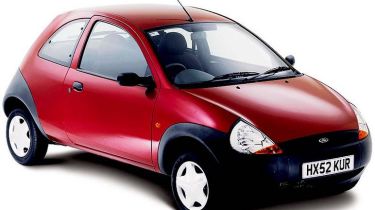Used Ford Ka review
The blue oval baby, the Ford Ka, is great value second-hand but what should you look out for?
Given the power of novelty to shift cars out of showrooms, the Ford Ka is something of a sensation. The little supermini survived virtually unaltered for eight years - a testimony to its original design. Only in 2003 were major changes introduced: an all-new 1.3-litre Duratec engine was offered, while the 1.6-litre Sportka and Streetka rag-top both hit the streets for the first time.
However, a long production run - along with cute, timeless looks, fun handling and value for money - have made the car hugely popular among used buyers. While the newer Streetka and Sportka are great machines in their own right, the original 1.3-litre model is a near-unbeatable package for the money. But there's a wide selection... so which is the best buy?
Checklist
- Wiring: the door wiring loom connectors can corrode on Ka2 and Ka3 models, which can cause powered window and central-locking failures. Replacing the wiring can cost as much as £300 for parts alone - with up to a full day's labour on top.
- Corrosion: major structural rust of the driver's door sill on early models can lead to an MoT failure. However, if rot appears on any undamaged body-work, fortunately it is covered by Ford's six-year corrosion warranty.
- Engine: on pre-February 2003 models, the engine can sound tappety, in which case a new set of cam followers may be required - and it's a costly job. Non-case-hardened cam followers wear away, making engine very noisy, so listen out for this.
- Steering: Racks are prone to failure, whether they're power-assisted or not. The parts alone are £500, and fitting is typically a further £200. On older cars, check service bills to see if the work has already been carried out.
- Brakes: either replace front pads at 18,000-20,000 miles or expect to have to fit new discs every 25,000 miles - more frequently if you do lots of stop-start driving. Fortunately, neither will break the bank, but always assess their condition.
Prices
You can buy an early (P-reg) example for as little as £1,500. Opt for a three-year-old Collection model and you can expect to pay £4,000, while an extra £1,000 should get a 30,000-mile Ka Luxury. Early (03-reg) Sportkas and Streetkas are available from £5,500 and £7,500 res-pectively. Year-old examples of either are typically around £2,000 more.
What to look for
Not all Ka models were fitted with power-assisted steering and, while un-assisted cars aren't unbearably heavy, PAS is still desirable, particularly for urban drivers. Due to the model's significant success, there are plenty of used examples to choose from, so buyers can afford to be picky and avoid high-mileage or neglected versions.
Recalls
December 1998: Attention due to reduction in braking efficiency. Affects cars with ABS, built from end of March 1998 to end of September 1998.
July 2002: Possibility of front brake-hose fouling on wheel rim and leaking.
Owner comment
Stuart Laughton from Huddersfield, West Yorkshire, has owned his Ka from new - and loves it. "It's rather tinny, but it's great to drive, cheap to run, and I can service it myself," he says.
"With three people on board, it's a bit underpowered. But if I'm travelling alone, it zips along quite happily. Although there's some rust coming through at the front, it's only cosmetic, and the front suspension bushes already need to be replaced. Still, I'd buy another Ka without hesitation."
Verdict
The Ka didn't fare very well in Auto Express's Driver Power 2005 reliability and satisfaction survey, coming a lowly 91st out of 100 vehicles. Although it scored highly for running costs, the brakes, performance and overall comfort attracted criticism. Nevertheless, if you're after some cheap chic you could do a lot worse than buy a Ka. Early models can look scruffy, yet a more recent example - or one of the many limited editions - has plenty to offer at a price that's hard to beat.








